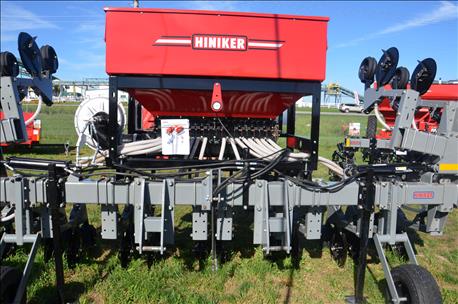
Four Penton Agriculture editors comb the Farm Progress Show each year looking for new products. Most expected the list to be much shorter this year. With all the talk of a tight ag economy, shrinking farm income and plummeting commodity prices, it seemed logical to expect companies to back off on showing new products.
The new-products team guessed wrong. The list of new products was as long this year as any other. At least two dozen products were prototypes that weren’t even named or priced yet.

NO NAME, NO MODEL NUMBER, NO LITERATURE: This product from Hiniker is so new the company hasn’t named it yet. It was one of many prototypes at the 2016 Farm Progress Show.
That’s not to say there weren’t signs of tight times at the show, or that the situation won’t change if tight times continue. More than one exhibitor noted a common theme. There was plenty of interest in new products, but potential customers said they would wait to see what their financial picture looked like after harvest. And at least one company that usually exhibits at every show elected not to come.
Nevertheless, new products abounded. And they weren’t all just updates of previous models. Two autonomous concept tractors were unveiled, as well as three multidirectional corn heads and a whole new concept in harvesting: the Tribine harvester.
So why do companies continue to develop new products? The new-products team put their heads together and came up with these four reasons.
1. Once technology advances reach critical mass, they are hard to stop.
For years we’ve joked that once the gates to the Farm Progress Show open, you best get out of the way, because it will happen with or without you.
Perhaps it’s the same way with technology. With all the advancements in GPS and the ability to send information to the cloud, it’s only natural to look at how to expand those same solutions to other products.
2. GPS technology spills over to farm implements.
At first, GPS technology and all that goes with it was geared primarily toward tractors, combines, sprayers and planters. Now companies are looking at how to use the same technology to help make other implements more efficient. At least two companies unveiled state-of-the-art fertilizer spreaders that make typical box-spinner spreaders look like Model T Ford cars.
3. Agriculture is cyclical, and companies understand the cycles.
If you haven’t sold corn for less than $3 per bushel, rest assured that either your dad or granddad has. Those operating ag companies realize that, too. Prices go up, and prices come down — all in accordance to supply and demand. While the boom period might have looked like the new normal, it now looks like another peak along a line of peaks and valleys dating back to the beginning of modern agriculture. Many companies are banking that prices will rebound. When they do, these companies believe you will want products with the latest technology, as long as it adds to your bottom line.
4. You can’t turn product development on and off on a dime.
Some of the new products, especially the prototypes, discovered at this year’s show were many months, if not years, in the making. The larger the company, the tougher it is to shut research and development on and off. So if farm income drops and sales sag, some research projects will still continue. When they result in a product ready for market, the company may bring it out, even if the sales environment isn’t ideal.
About the Author(s)
You May Also Like




